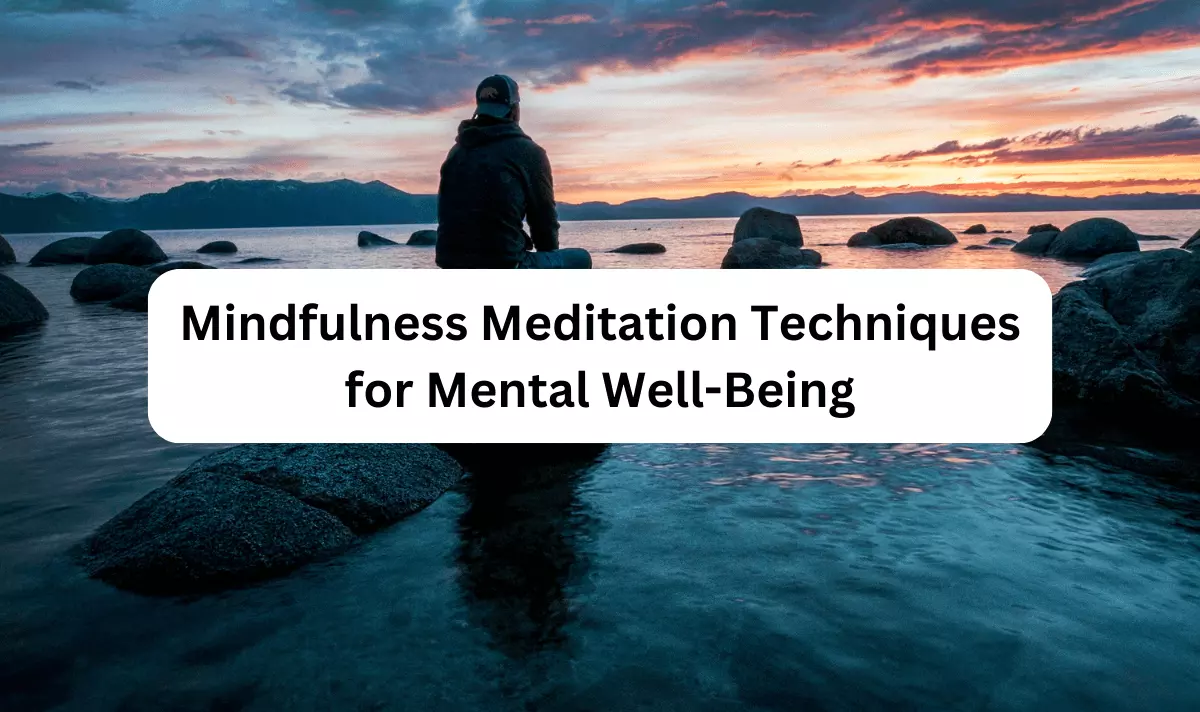
Finding ways to cultivate mental well-being has become increasingly important. Mindfulness meditation offers a powerful and accessible technique to promote mental clarity, reduce stress, and enhance overall well-being. This article explores various mindfulness meditation techniques that can be easily incorporated into daily life for improved mental health and a greater sense of inner peace.
May you also like this: How to Improve Sleep Quality Naturally
Content
What is Mindfulness Meditation?

Mindfulness meditation is a practice that involves intentionally bringing one’s attention to the present moment without judgment. It is about observing thoughts, emotions, and sensations as they arise, fostering a sense of non-reactivity and acceptance. By cultivating mindfulness, individuals can develop a deeper understanding of themselves and their experiences, leading to greater clarity and emotional well-being.
Benefits of Mindfulness Meditation
Mindfulness meditation offers a wide range of benefits for mental well-being:
- Reduced Stress: Regular practice of mindfulness meditation has been shown to reduce stress levels and promote relaxation. By focusing on the present moment and letting go of worries about the past or future, individuals can experience a greater sense of calm and tranquility.
- Improved Emotional Regulation: Mindfulness meditation enhances emotional awareness and helps individuals develop healthier ways of responding to challenging situations. It allows for a more balanced perspective, reducing the likelihood of reactive and impulsive behaviors.
- Enhanced Concentration: The practice of mindfulness meditation trains the mind to sustain attention and resist distractions. This can lead to improved concentration and mental focus, both in meditation and daily activities.
- Better Sleep: Mindfulness meditation promotes relaxation and can help individuals struggling with sleep issues. By practicing mindfulness before bed, individuals can create a peaceful transition from the busyness of the day to a restful night’s sleep.
Getting Started with Mindfulness Meditation
To begin your mindfulness meditation journey, follow these steps:
Creating a Peaceful Environment
Find a quiet and comfortable space where you can practice without distractions. Dim the lights, play soft music if desired, and create an atmosphere conducive to relaxation.
Adopting a Comfortable Posture
Sit in a position that allows you to be alert yet relaxed. You can sit cross-legged on a cushion or use a chair with your feet flat on the ground. Maintain an upright posture with a relaxed and open stance.
Focusing on the Breath
Bring your attention to your breath. Notice the sensation of the breath entering and leaving your body. Use the breath as an anchor to the present moment, allowing other thoughts to come and go without judgment.
Mindful Breathing Meditation
Mindful breathing meditation is a fundamental practice in mindfulness. It involves directing full attention to the breath, cultivating awareness and presence. Here are three techniques to try:
Breath Awareness

Focus your attention on the natural rhythm of your breath. Notice the sensations in your nostrils or the rise and fall of your abdomen as you breathe in and out. Be fully present with each breath.
Counting the Breath
Count each inhale and exhale, starting from one and going up to ten. If your mind wanders, gently bring it back to the breath and resume counting from where you left off. This practice helps develop concentration.
Deep Belly Breathing
Place one hand on your abdomen and take slow, deep breaths. Feel your belly rise on the inhalation and fall on the exhalation. This technique promotes relaxation and can help calm an anxious mind.
Body Scan Meditation
Body scan meditation involves systematically directing your attention to different parts of the body, observing physical sensations and releasing tension. Start from the top of your head and progressively move down to your toes, focusing on each area and noticing any sensations or areas of discomfort.
Loving-Kindness Meditation
Loving-kindness meditation cultivates compassion and kindness towards oneself and others. Begin by generating feelings of love and well-wishes for yourself. Then extend these feelings to loved ones, acquaintances, neutral people, and even challenging individuals. This practice promotes empathy and connection.
Walking Meditation
Walking meditation involves bringing mindfulness into the act of walking. Slow down your pace, and pay attention to each step. Notice the sensation of your feet touching the ground, the movement of your body, and the environment around you. This practice can be done indoors or outdoors.
Mindfulness in Everyday Activities
Mindfulness can be integrated into various daily activities, enhancing awareness and presence in each moment. Here are a few examples:
Mindful Eating
Pay close attention to the taste, texture, and smell of your food. Chew slowly and savor each bite. Be fully present during the meal, avoiding distractions like phones or screens.
Mindful Listening
When engaging in conversation or listening to others, give your full attention. Practice active listening by focusing on the speaker’s words and body language. Avoid interrupting or formulating responses in your mind.
Mindful Movement
Whether it’s yoga, stretching, or any form of physical exercise, approach it mindfully. Pay attention to the sensations in your body, your breathing, and the movements you make. Allow yourself to be fully present in the activity.
Overcoming Common Challenges in Mindfulness Meditation

As with any practice, mindfulness meditation can present challenges along the way. Here are some common obstacles and how to address them:
Restlessness and Impatience
Restlessness and impatience are natural experiences that arise during meditation. Instead of resisting them, acknowledge their presence and let them be. Gently guide your attention back to your breath or chosen focus point.
Wandering Thoughts
Thoughts will inevitably arise during meditation. Rather than getting caught up in them or judging their content, simply observe them and return your focus to the present moment. Treat thoughts as passing clouds in the sky of your mind.
Physical Discomfort
It’s common to experience physical discomfort during meditation, such as stiffness or discomfort in the legs or back. Adjust your posture as needed, maintaining a balance between alertness and comfort. If discomfort persists, explore alternative meditation positions or use cushions for support.
Cultivating Mindfulness Beyond Meditation
While formal meditation is valuable, mindfulness can also be practiced throughout the day. Take moments to pause, breathe, and bring your attention to the present moment. Engage in activities with intention, savoring the simple joys of life. By integrating mindfulness into your daily routine, you can nurture mental well-being on an ongoing basis.
Conclusion
Mindfulness meditation techniques offer a pathway to improved mental well-being. By incorporating these practices into your life, you can cultivate a greater sense of clarity, emotional resilience, and inner peace. Remember to start with small steps, be patient with yourself, and embrace the journey of self-discovery and growth.
u003cstrongu003eIs mindfulness meditation suitable for everyone?u003c/strongu003e
Yes, mindfulness meditation is accessible to people of all ages and backgrounds. It can benefit anyone seeking to enhance their mental well-being.
u003cstrongu003eHow long should I meditate each day?u003c/strongu003e
Start with a few minutes of meditation daily and gradually increase the duration as you become more comfortable. Consistency is more important than the length of each session.
u003cstrongu003eCan mindfulness meditation help with anxiety and depression?u003c/strongu003e
Yes, mindfulness meditation has shown positive effects in reducing symptoms of anxiety and depression. However, it’s important to consult with a healthcare professional for personalized guidance.
u003cstrongu003eCan I practice mindfulness meditation while doing other activities?u003c/strongu003e
Absolutely! You can infuse mindfulness into everyday activities like washing dishes, walking, or even brushing your teeth. It’s about being fully present in the moment.
u003cstrongu003eWhere can I learn more about mindfulness meditation?u003c/strongu003e
There are various resources available, including books, online courses, and meditation apps. Explore different options to find what resonates with you and supports your practice.

Gina Jordan is a health blog author who has been writing about healthy living since 2013. She started her journey by adopting a vegan diet and eating only organic foods, but the more she learned, the more she realized that we should all be eating plant-based diets exclusively. As an expert in nutrition and wellness, Gina blogs to educate readers on how they can live happier and healthier lives through food choices!













